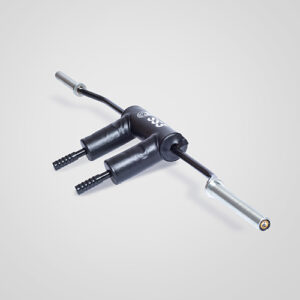Bells of Steel SS3 Safety Squat Bar Review
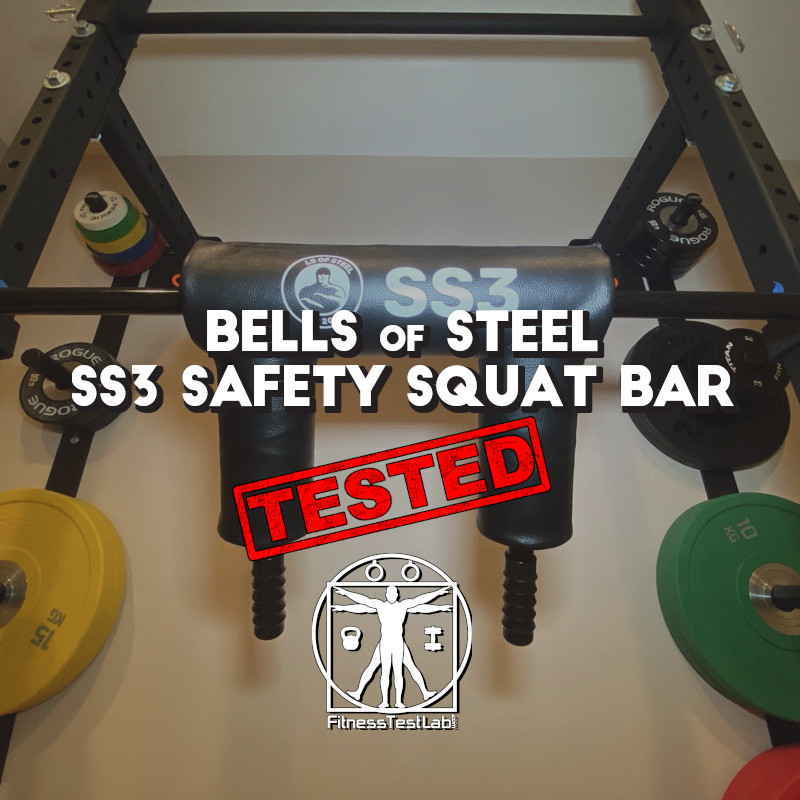
If you’d like to make heavy squats more accessible and easy on your neck and shoulders, then a safety squat bar is a must-have for your home gym.
I recently had the opportunity to test the premier SS3 Safety Squat Bar from Bells of Steel, and I can confidently say that it delivers on its promise to improve the squatting experience of lifters with mobility issues.
It’s also great for non-competitive powerlifters looking to improve their overall squat form.
Keep reading to learn more about this must-have piece of fitness equipment.
Summary
The Bells of Steel SS3 Safety Squat Bar is a high quality specialty barbell that offers several variations of a traditional barbell back squat.
If I could sum up the main benefit of the SS3 in one word, it would be versatility.
Between multiple handle options that can be pushed or pulled and two ways to load the bar on your shoulders, the SS3 offers several different ways to perform a loaded back squat that provide more potential for strength adaptations.
The SS3 bar is comfortable to use, easy to move around, and can be used for exercises other than squats, such as lunges and good mornings. It’s a great tool for those like me looking to add variety to their workouts and safely maintain strength as we age.
The SS3 provides great value for the price and it has earned a permanent place in my home gym.
I would recommend it to nearly everyone, although competitive powerlifters will not want to completely replace regular barbell squats with this bar. On average, you’ll lift about %11 less weight with the SS3 than a standard Olympic bar, so if you compete you’ll need to keep practicing with your regular Olympic bar.
The one drawback to this bar is that it will not fit properly on many of the more popular racks on the market, which are usually 48″ wide.
Regardless, this bar works great for me and I definitely recommend it. Two biceps up for the Bells of Steel SS3 Safety Squat Bar! 💪💪
SS3 Safety Squat Bar specs
One of the unique features of the Bells of Steel SS3 Safety Squat Bar is its customizable handle attachments, which allow users to perform the squat with different body mechanics.
I’ll cover the three handle options in more detail later in this review.
The SS3 bar has rotating Olympic-sized sleeves and a 1500lb weight capacity, so it will work for even the most beastly of you lifters out there.
The SS3 bar specs include:
- 1.2″ diameter shaft
- 86.5″ overall length
- 47.5lbs weight
- Black zinc shaft
- Single pad design
- Rotating sleeves
- 3 styles of removable handles
- 1,500lb capacity
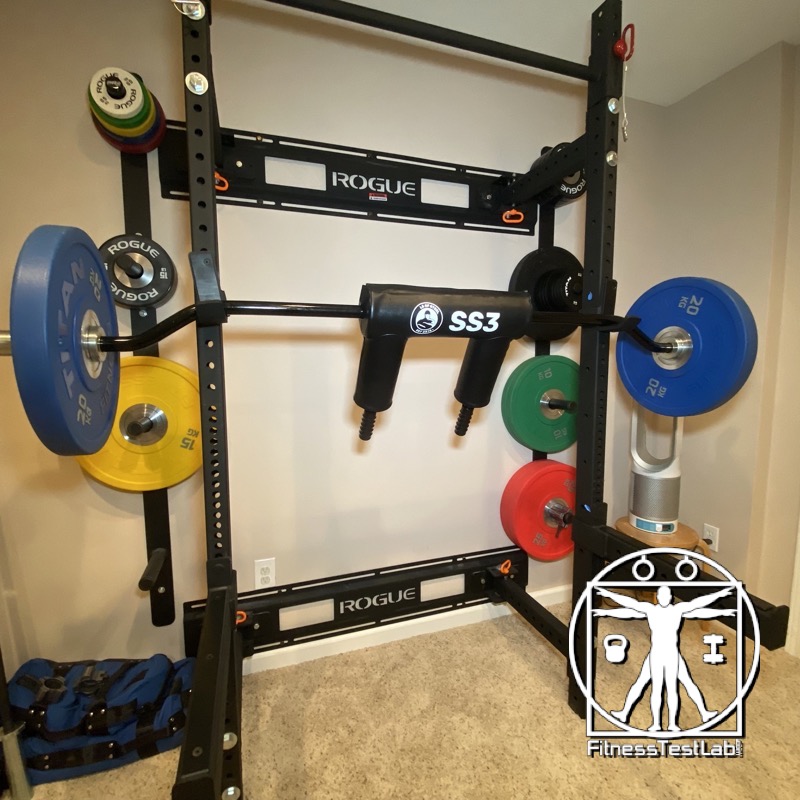
Why use an SS3 Safety Squat Bar?
A safety squat bar like the Bells of Steel SS3 Safety Squat Bar is a specialized barbell with a yoke design that allows the weight to be loaded on the back of the shoulders rather than on the neck.
Using a safety squat bar allows for a more comfortable loading of the weight on the upper back, reducing the risk of injury and increasing safety during squats.
There are several benefits to using the SS3 Safety Squat Bar:
- Comfort: The yoke design of the safety squat bar distributes the weight more evenly across the back, which can be more comfortable for some people compared to a traditional barbell. This can be particularly helpful for those with shoulder or neck injuries.
- Form: The yoke design of the safety squat bar also allows for a more upright posture during squats, which can help to correct form and reduce the risk of injury.
- Increased muscle activation: Research has found that using a safety squat bar can lead to greater muscle activation in the quadriceps and lower back compared to using a traditional barbell.
- Versatility: The safety squat bar can be used for a variety of exercises, including squats, lunges, good mornings, and more. The different handle options and two ways to hold the barbell on your shoulders provide more opportunity for broader strength gains.
I want to safely maintain strength as I age (I’m 48 at the time of this writing), so specialty bars like the SS3 that are designed to make lifting safer while offering more versatility are very appealing to me.
If you’re getting up in age like I am, then using a safety squat bar like the SS3 can definitely help you lift stronger and live longer.
SS3 Safety Squat Bar unboxing
The Bells of Steel SS3 Safety Squat Bar came in a HUGE box.
Not surprising considering the size of the bar, but I do sometimes feel bad for the delivery person that is constantly lugging heavy boxes to my door ¯\_(ツ)_/¯
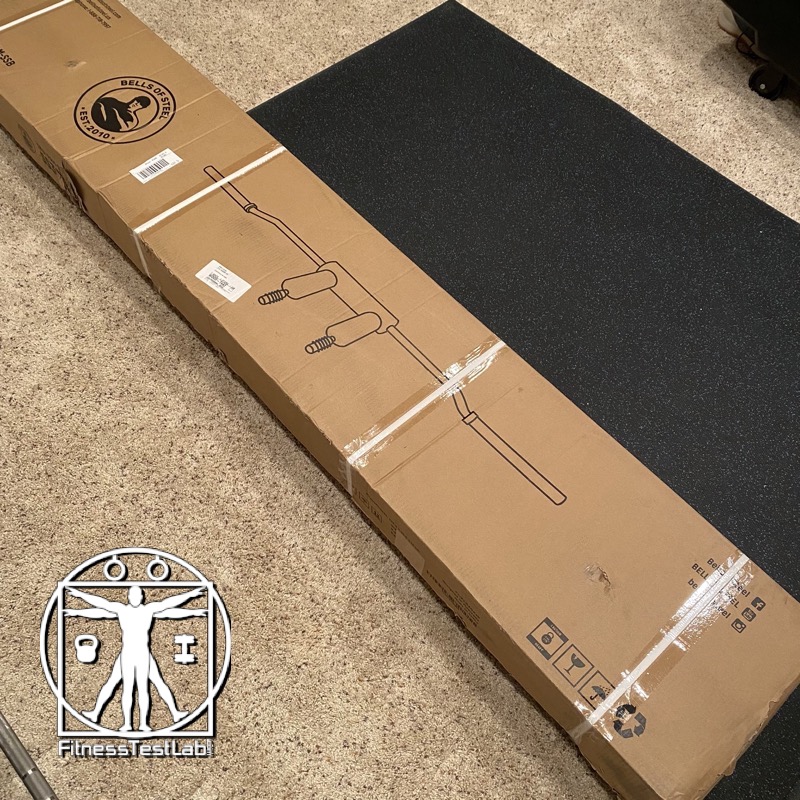
The box was a little bit beat up during delivery, but thankfully the bar was well packed.
I’ve seen the Bells of Steel CEO on Youtube talking about the care they take in packing equipment, and that care was evident with how well the SS3 was packed.
The bar was protected with styrofoam that kept the box shape intact, despite the mild beating it took during shipping.
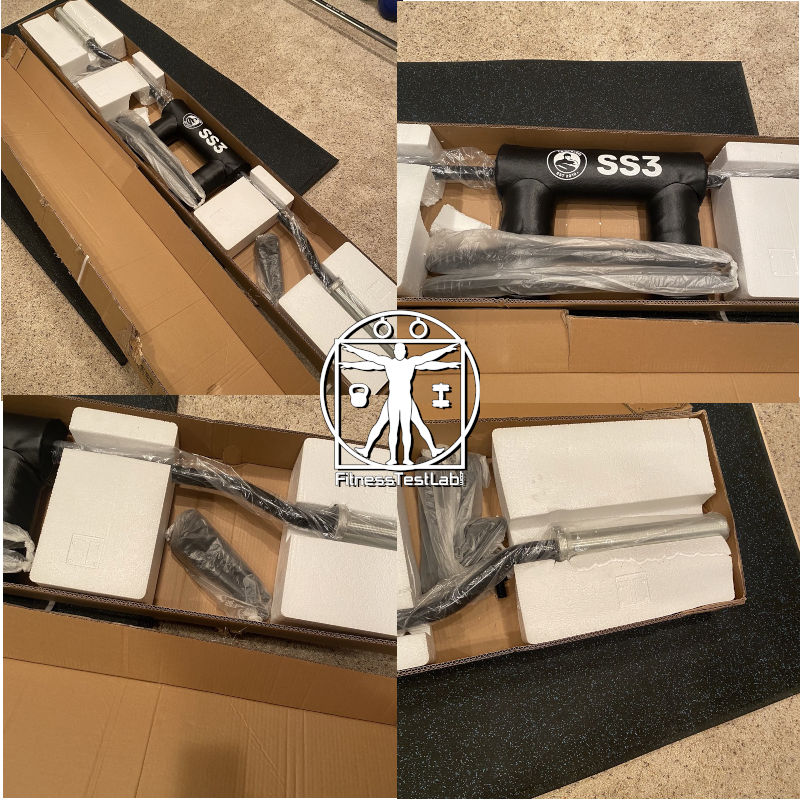
At the time I write this, the Bells of Steel SS3 Safety Squat Bar includes three different styles of handle attachments.
For some reason, the handles were not packed as well as the bar. You can see the chain handles sitting in the box in the bottom left corner of the unboxing picture above, with no protection other than a plastic bag.
But, thankfully they were not damaged in any way during shipping.
SS3 Safety Squat Bar impressions
Weighing in at 47.4 pounds, the Bells of Steel SS3 Safety Squat Bar feels substantial without being cumbersome.
It’s not much heaver than a regular Olympic bar, which makes it easy to move around when I want to use it or put it away.
The SS3 bar feels sturdy and well made. The SS3 has rotating sleeves, which is uncommon for this type of bar. Rotating sleeves are not necessary on a safety squat bar like the SS3, but it’s a nice touch.
The sleeves are also Olympic-sized, meaning that they work with all Olympic plates and collars designed for Olympic barbells. This is not always the case when it comes to specialty bars.
The one nitpick I have with the SS3, and it could be a major nit depending on your situation, is that it doesn’t fit on a commonly-sized 48-inch-wide squat rack.
The shaft of a standard 7ft Olympic barbell is approximately 52 inches between collars.
Many popular squat racks, like my Rogue R-3W Folding Infinity-Series Rack (full review) are sized to accommodate a full size barbell.
The SS3 has only 46.5 inches of shaft length between the cambered sections of the bar, so it does not fit snugly on my rack.
As you can see in the picture below, the SS3 causes my J-cups to tilt inward when racked.
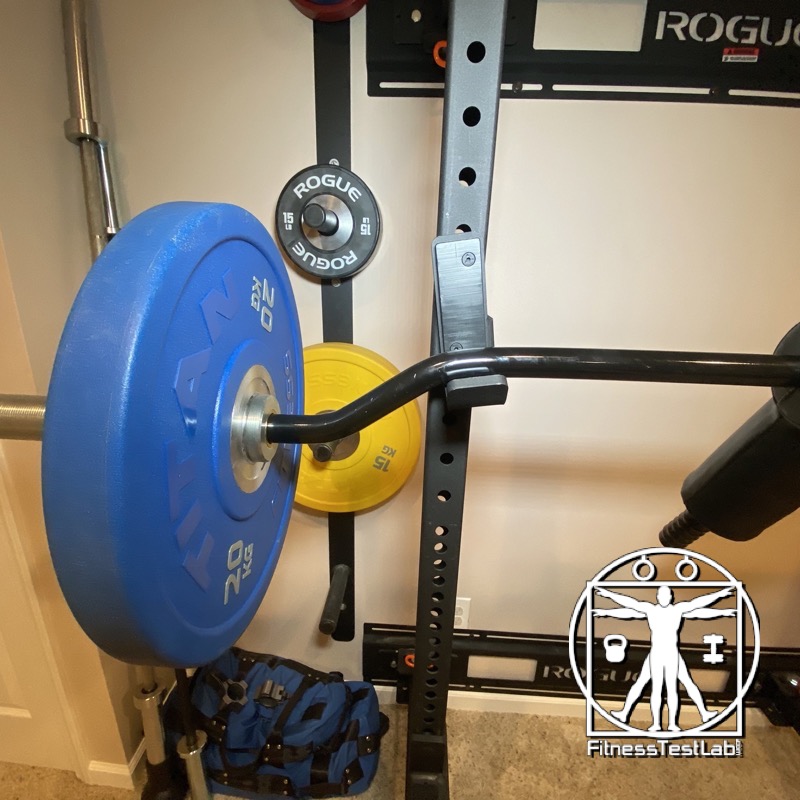
The SS3 is almost too narrow for my Rogue Infinity rack
The tilt alters the weight distribution on the J-cups, so heavy weight is going to put a strain on the cups in a way they weren’t designed for.
It could be a non-issue, but it’s definitely not how J-cups are intended to be used.
So, if you squat really heavy and you own a standard-sized rack, you should take this into account when deciding on the SS3.
How to use the SS3 Safety Squat Bar
The Bells of Steel SS3 is the first safety squat bar I’ve ever used. Since I’ve no experience with this kind of bar, I had questions.
Which side of the tilted bar should I load on my shoulders?
How do I properly use the handles?
Is it easer to squat with a safety squat bar?
I went where I always go when I have questions – the internet!
Unfortunately, in this case I did not find clear answers to the questions I had. I watched three different tutorial videos and somehow got five different answers.
So I’ll give you my take on how to use a safety squat bar now that I’ve had some time to experiment.
What side of the SS3 Safety Squat Bar should I load on my shoulders?
As you can see in the picture below, the padded handlebars are tilted at an angle when the bar is racked, due to the camber of the bar at both ends.
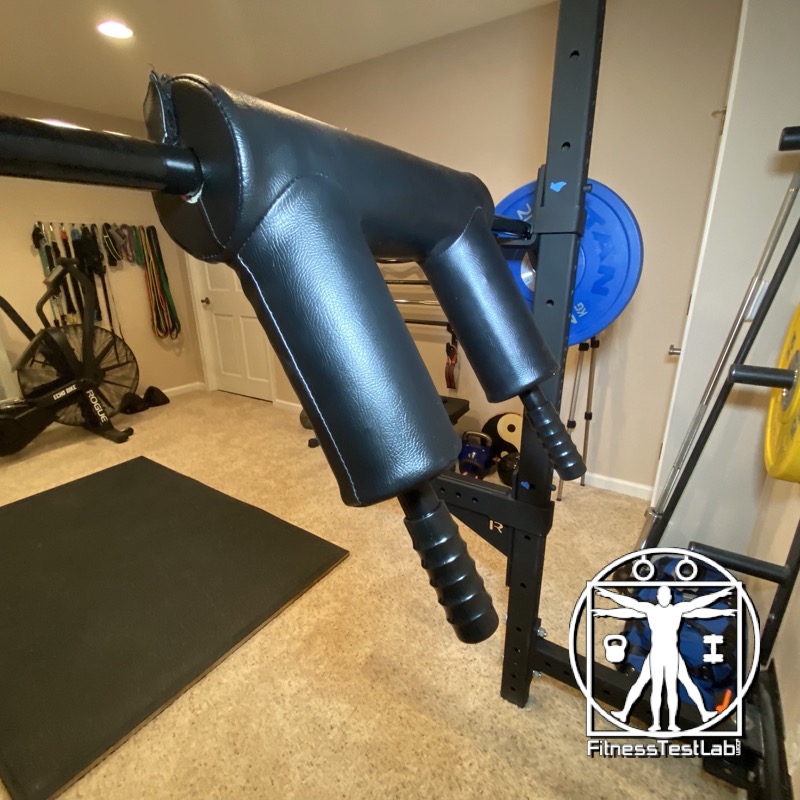
If the Bells of Steel logo on the SS3 was printed on the tilted-side-up side of the padding, I would just assume that I load the bar by stepping under the tilt.
That would be easy and obvious.
However, the logo is printed on the tilt-side-down side of the padding, which makes me think I should maybe load the bar by pushing into the tilt.
I hope that makes sense. In any case, I tried it both ways.
Pushing into the tilt causes the camber to extend further out into space, becoming nearly horizontal, which moves the bar’s center of mass closer to my center of gravity.
Loading the bar like this makes the movement feel like a cross between a front squat and a back squat. The bar is also easier to balance on my shoulders when I load this way.
In contrast, loading by stepping under the tilt results in a load that feels closer to a traditional back squat. If I didn’t hold on to the handles when I load this way, the bar would slip off my back.
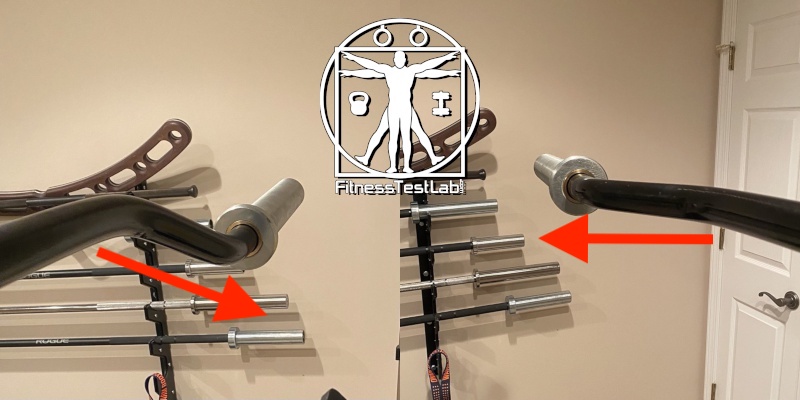
Loading under the tilt (left) vs pushing into the tilt (right)
How do I properly use the handles of an SS3 safety squat bar?
Note that I’m not referring to the different handle options here. I’ll get to those in a bit.
I’m referring to the ability to push up or pull down on the handles during a squat.
There are two schools of thought on which one is correct, depending on which fitness guru you want to listen to.
After trying them both, I’ll refer to them as the straight back method and the round back method.

Straight back method
When you’re just starting out using the SS3 Safety Squat Bar, the easiest way to use the handles is to push up on them while you squat.
Push up on the handles to keep them at a slight angle toward the ground throughout each rep and try to keep your forearms at the same angle as you come up from the bottom of the squat.
This approach engages the upper back in a way similar to a front squat, which transforms a squat with the SS3 into a cross between a back squat and a front squat.
Round back method
The arguably more advanced method is to pull the handles down while squatting, which results in an extension of your upper back.
“Hold up!”, you might be thinking. “Shouldn’t I avoid rounding my back when I squat?”
Ordinarily, yes – it’s true that you should avoid spinal flexion, especially when lifting heavy weights.
But the spine has four parts – cervical, thoracic, lumbar, and sacrum. When you squat with a safety squat bar and pull down on the handles, you’re intentionally flexing the thoracic (upper) spine, not the other three.
Flexing the thoracic spine allows you to train a group of muscles called the erectors, which are important for upper back strength.
However, these muscles can’t be consciously controlled, which means they can only be activated when they’re put in a position where they have to work. Like resisting a safety squat bar with the handles being pulled down.
So, by flexing the thoracic spine, you’re putting these muscles in a position where they have to be active.
If you’ve never used a safety squat bar before, I suggest using the straight back method till you get your working weight dialed in with the SS3 before trying the rounded back method.
Your back will thank you.

This padding is thicc
Is it easier to squat with a safety squat bar like the SS3?
The answer is…yes and no.
Personally, I find squatting with a safety squat bar to be easier on my neck and shoulders, but I can’t squat as much weight.
My experience is backed up by research.
According to a study done on the effects of the safety squat bar on trunk and lower-body mechanics, lifters are able to squat 11.3% more weight with an Olympic barbell than a safety squat bar.
So you competitive powerlifters out there aren’t going to want to give up regular barbell squats in favor of a safety squat bar.
Certain muscles, like the rectus abdominis, medial/lateral hamstrings, and vastus lateralis, are used more when squatting with a barbell. But the lower trap muscle is actually more active when using a safety squat bar.
There are also some differences in how people move while squatting – they tend to have more hip flexion, ankle dorsiflexion, and forward lean when using a regular Olympic barbell.
But according to the study, there aren’t really any significant differences in muscle activation for the glutes, vastus medialis, rectus femoris, spinal erector, lats, middle trap, or obliques, and there’s no significant difference in peak knee flexion either.
This is good news, since you’re not sacrificing much on your squat to use a safety squat bar, while still reaping the benefits offered from using one.
SS3 handle attachments
The Bells of Steel SS3 Safety Squat Bar comes with three removable handle options. As far as I’m aware, the SS3 is the only safety squat bar with this feature.
The three handle types are:
- Regular handles (short grip)
- Spider handles (long grip)
- Chain handles (nunchuck grip)
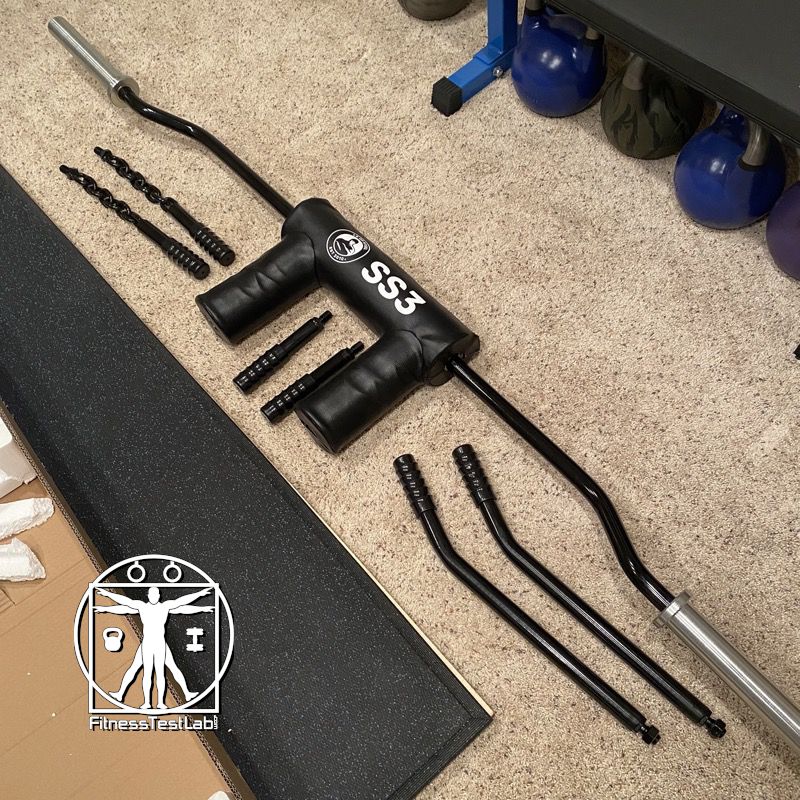
Three different handle options
Each handle option brings a unique aspect to squatting with the SS3 Safety Squat Bar.
Regular handles
The regular handles are just that – regular.
These are the same handles that you’d find on nearly any other safety squat bar on the market.
Spider handles
The spider handles are much longer versions of the regular handles that change the dynamics of the squat.
With the short handles, it’s possible to keep your shoulder blades tight and your upper back ramrod straight.
The long handles don’t really allow you to do that. They almost encourage you to round your upper back as you squat, and they certainly make it easier to perform the ’round back method’ squat that I described above.
Chain handles
The chain handles are by far the most difficult handle option to use. Unlike with the other two options, you can’t push down or pull up on these handles – all you can do is pull outward.
Without the added stability of pressing up or pulling down, nearly all the stability has to come from your core. These handles provide a safer option that squatting hands-free, as some people (not me) like to do.
Needless to say, I hate these handles because they make the lift much harder.
But in a good way. It’s a love/hate relationship.
Final Thoughts
The Bells of Steel SS3 Safety Squat Bar is an exceptional specialty barbell that offers several variations of the traditional back squat.
Versatility is the main benefit of the SS3, as it has multiple handle options that can be pulled or pushed and two ways to load the bar on your shoulders.
The SS3 is comfortable to use, easy to move around, and can be used for exercises other than squats, such as lunges and good mornings.
It is a valuable tool for those looking to add variety to their workouts and safely maintain strength as they age. While competitive powerlifters may not want to completely replace regular barbell squats with this bar, it is a great choice for most people.
However, it may not fit properly on many popular racks that are usually 48″ wide. Despite this, the SS3 has earned a permanent spot on my barbell rack.
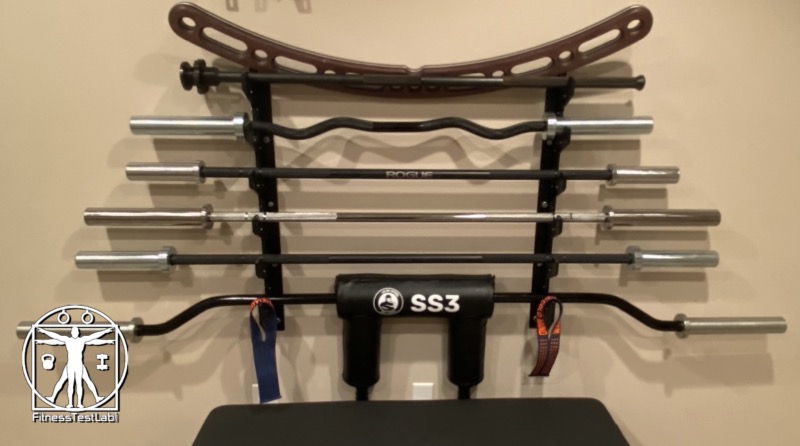
About the Author Mario
I'm a software product manager with a full-time job, family, and a desire to stay strong, mobile, and fit. I separate fact from fiction to find the most effective and affordable options for home fitness. If you'd like to build your own home gym, start here.
Popular posts
Session expired
Please log in again. The login page will open in a new tab. After logging in you can close it and return to this page.

